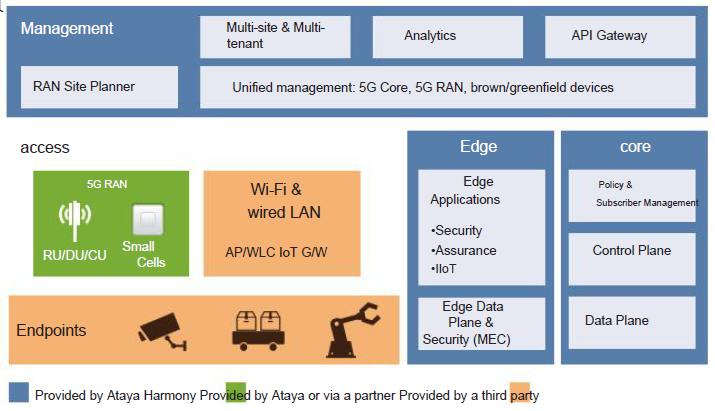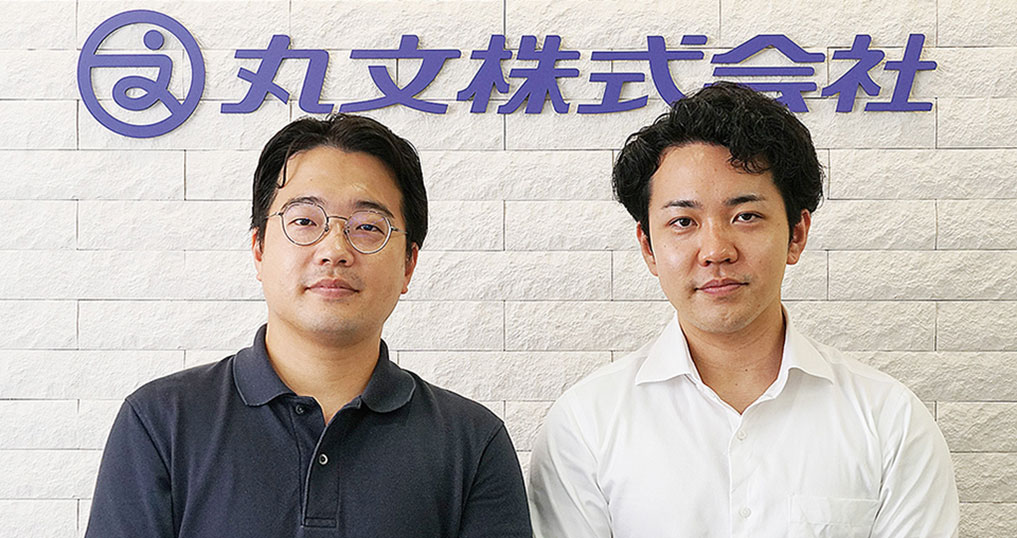Marubun has begun to offer new solutions to accelerate the expansion of the local 5G market: 5GC, which allows integrated management of local 5G, Wi-Fi, and wired LAN; an all-in-one local 5G solution that can be easily deployed like cloud-based Wi-Fi; and a support service for wireless area design.
Marubun, which has focused on local 5G since its inception, is further strengthening its lineup.
In July of this year, the company signed an agency agreement with Ataya, a US company, and will launch two new local 5G solutions. Both are groundbreaking solutions that will bring a breath of fresh air to the local 5G market.
The first is “Harmony,” a 5GC (5G Core Network) product for local 5G. Its biggest feature is that it can also manage things other than local 5G in an integrated manner. Marubun’s Nemoto Hayato explains, “Manufacturers call it the ‘Universal Connectivity Platform,’ and it can centrally manage wireless and wired networks other than 5G RAN. If you introduce local 5G using Harmony, Wi-Fi access points and wired LAN products will also be listed on the management screen, allowing consistent policy control, etc.”

Integrated management can be achieved without updating existing network equipment, providing benefits such as improved operational efficiency and preventing missed security policy configurations.
In addition, multiple connections between local 5G and Wi-Fi will also be possible. “Harmony supports multipath TCP, which increases redundancy by using multiple paths simultaneously. For example, you can use local 5G as the main and Wi-Fi as the sub to create a highly stable network,” said Nemoto.
Harmony is a container-based software product that can be deployed in the cloud or on-premise. It also has a full range of multi-tenant functions for service providers, etc. It also supports micro-segmentation, which isolates the environment for each user company and prevents malware infection in one tenant from affecting other tenants.
In addition, Harmony, a multi-vendor compatible 5GC, can be combined with RU/DU/CU from various vendors, and Marubun can also provide RU/DU/CU that have been connection verified.
Wi-Fi-like local 5G that can be used in just 5 minutes
Another Ataya product that Marubun will begin handling is “Chorus,” an all-in-one local 5G solution consisting of a small 5G base station “Chorus AP” and a cloud-based management platform. “It was developed with a ‘Wi-Fi-like’ concept,” Nemoto explains.
What makes it Wi-Fi-like is how easy it is to install. Just bring a Chorus AP that has already been configured on the cloud to the site, plug in the LAN cable, and power it on, and “you’ll be communicating via local 5G in about five minutes,” says Nemoto. In other words, Chorus is the local 5G version of cloud-based Wi-Fi.

And as for the cost, it is Wi-Fi-like and can be offered to service providers at a very competitive price.
There are also some impressive features in terms of functionality. For example, local breakout. The base station Chorus AP is equipped with a UPF (User Plane Function) function that processes actual user data, allowing user data to remain within the local network without going through the cloud. This allows for high security, low latency, and reduced WAN traffic. With Ataya’s solution arriving in Japan, the domestic local 5G market will see major changes from now on.
Attending meetings with users and accompanying them in wireless design
In order to solve the problems of network equipment vendors and local 5G operators, Marubun also began offering a “wireless area design support service” in August of this year.

“Ranplan Professional,” a radio wave propagation simulation tool from British company Ranplan that Marubun handles, is a well-established tool that is widely used in Japan as well. “Its unique feature is that it supports both indoor and outdoor use. It can visualize on a heat map how radio waves from an indoor base station leak to the outdoors, and conversely, how radio waves from a base station installed outdoors affect indoors,” explains Ryuhei Ogawa of Marubun.
The richness of the system database is one of Ranplan’s strengths. More than 900 systems are registered, making it easy to set parameters for 5G NR systems. “It supports a full range of wireless stations, and not only local 5G, but also LTE, Wi-Fi, and other systems,” says Ogawa. It also supports 3D beamforming using Massive MIMO.
There are two types of simulations that can be performed: in addition to 3D radio wave propagation, it can also simulate user QoE (quality of experience). “You can place users in a room and simulate throughput by setting their actions, such as ‘web browsing’ or ‘making a video call,'” says Ogawa.

Ranplan is popular among many users because of these many attractive features. However, according to Ogawa, they also received a lot of feedback, such as “I want to use Ranplan on an occasional basis without purchasing it” and “There is a shortage of people who can use Ranplan effectively.”
That’s why, together with Basis, a company with a leading track record in wireless communication infrastructure engineering in Japan, we have started a wireless area design support service. We provide support to network equipment vendors who want to visualize and promote the radio wave propagation performance of their base stations, antennas, reflectors, etc., as well as local 5G operators who want to efficiently perform radio wave propagation simulations for license applications and station placement designs.
Specifically, they attend meetings with end users and quickly carry out simulations based on requests that arise there. They also hold regular web meetings to give lectures on how to use the tools. “You can use the tools without purchasing the product, keeping initial costs down like a subscription service. Also, as we call it an accompanying service, we support customers until they are able to operate the tools themselves,” says Ogawa. They also handle one-off projects.
According to Marubun, the local 5G market has become even more active since last winter. With the emergence of these three new solutions as a driving force, it looks like we are finally entering a phase of full-scale adoption.
Contact
Marubun Corporation
Entrepreneur Business Headquarters Iris Company
TEL: 03-3639-1336
E-mail: telecom_buz@marubun.co.jp



